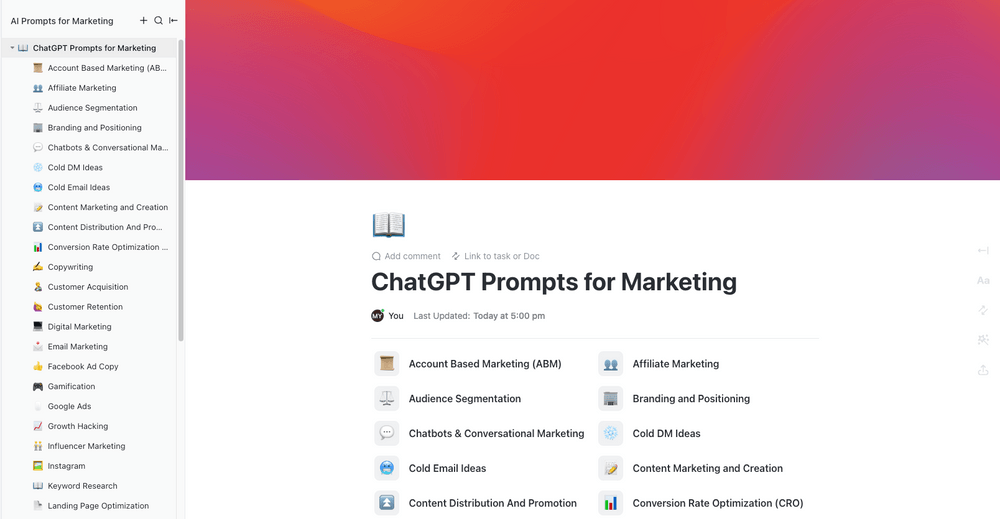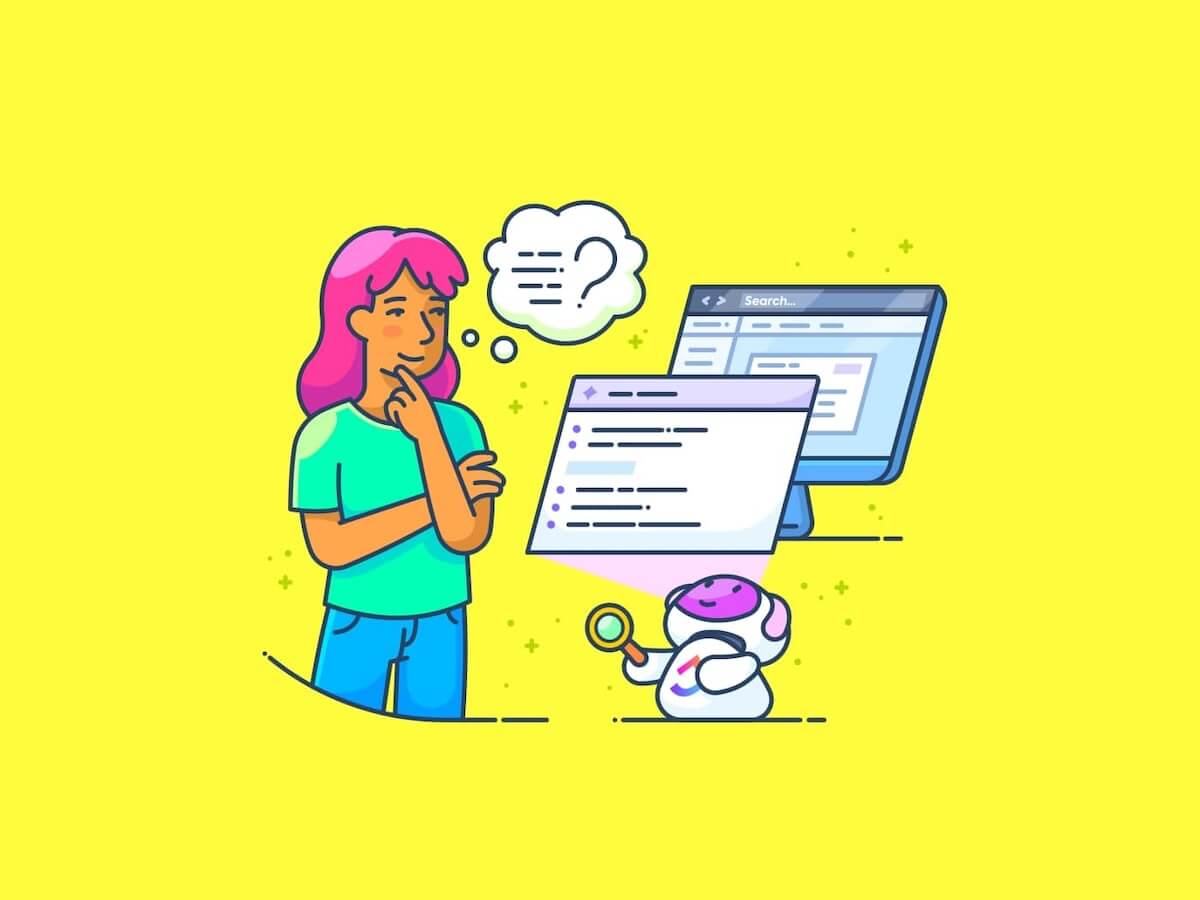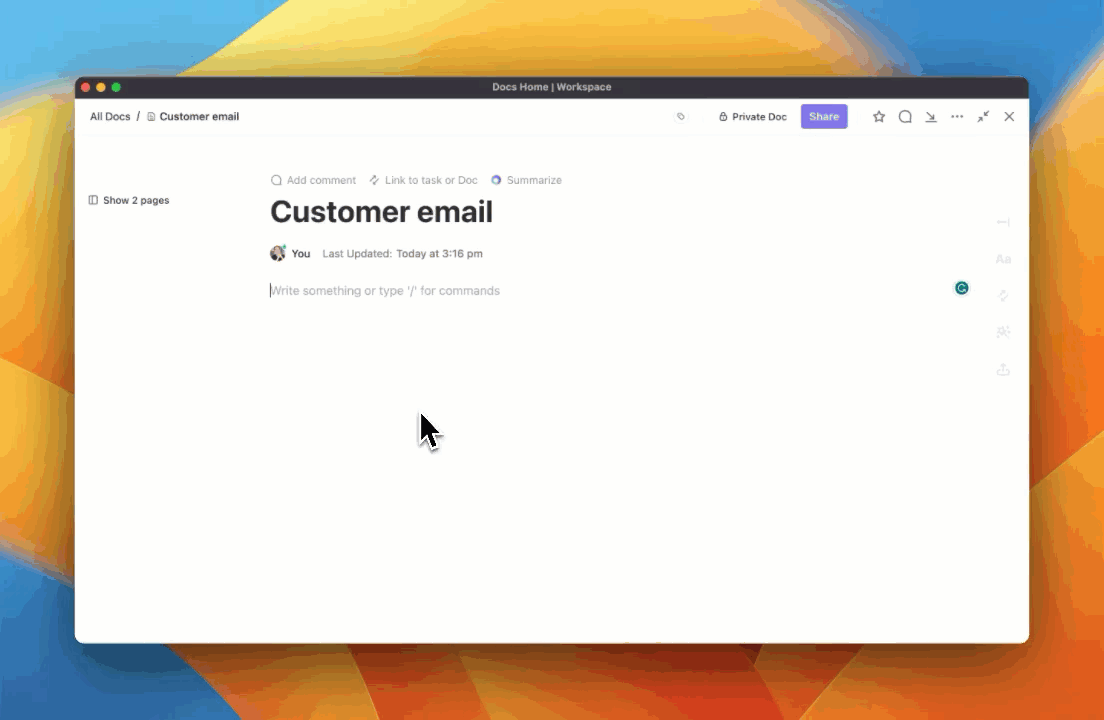Artificial intelligence (AI) has officially left sci-fi movies and has gone straight into the electronic devices of our everyday lives. 🤖
Thanks to AI-powered chatbots like ChatGPT, getting answers to any question is as simple as texting a friend. This is super helpful for brainstorming ideas, conducting research, and drafting any type of content.
And the best part?
The response time. The learning is immediate.
But here’s the thing:
If you want to get relevant answers without wasting time, you must know how to ask AI a question effectively. No, it’s not rocket science—you just need to know which pitfalls to avoid and the proper techniques to use.
That’s where this handy guide comes in.
And if you’re curious about the broader context of AI, we’ll dive into how it works and discuss its ethical and privacy considerations. This way, when choosing AI tools, you’ll know what to look for—like training data limitations and data handling.
Ready? Let’s go!
Understanding AI and How It Works
AI is a field of computer science that builds robots and computer systems to carry out human-like tasks with higher accuracy and in a fraction of the time. ⚡
This is achieved through different branches of AI like:
- Machine learning: This uses algorithms and large datasets to build self-learning models. These models allow computer systems to autonomously learn new data, recognize patterns, and make decisions
- Deep learning: This subset of machine learning mimics the human brain. Like brain neurons, it uses artificial neural networks (a set of complex algorithms) to learn from enormous amounts of data. So if you feed a neural network with pictures of cats and dogs, it’ll learn to identify other cats and dogs 🐱 🐶
- Natural language processing (NLP): A branch of AI that teaches computers and robots to interact with human language, just like we do. AI can then understand spoken and written words, interpret them, and respond in a way that makes sense to us
These days, AI is synonymous with the powerful technologies that power our favorite apps and machines. Popular options include:
- ChatGPT and ClickUp AI for generating content in response to our queries
- Amazon, Netflix, and Spotify for recommending products, movies, and songs based on our past behavior and preferences
- Siri, Alexa, and Google Assistant for understanding and responding to our spoken commands
- Tesla for making real-time driving decisions on the road
Common Mistakes Humans Make When Asking AI Questions
Large language models (LLMs) like OpenAI’s ChatGPT have become integral to breezing through personal and professional tasks like writing emails, generating code, and drafting marketing plans. 📝
But if you’re just starting with AI, you’ll likely make many mistakes and get frustrated with the responses. That’s why knowing how to ask AI a question is key. To eliminate the hassle and save time, here are some common mistakes to avoid when asking AI questions.
1. Asking vague questions
While AI tools have many advanced functionalities, mind reading isn’t one of them.
The quality of responses you receive is tied to the clarity and detail of your input. If your questions are vague or the information provided is inaccurate, expect to receive answers that are generic, incorrect, or not applicable to what you need.
Before hitting “send” on your question, take a moment to consider what you want to know and include as many relevant details (like purpose, context, and preferences) as possible. ✍️
2. Providing little to no context
AI tools often require context to understand the intent behind a question. Otherwise, you’ll end up with technically correct responses that are irrelevant and inapplicable to you.
Provide the AI tool with your question who, what, where, when, and why.
Let’s say you need help planning an event. Mentioning the type of event, its location, the date, and who will be attending is critical. This context allows the AI to tailor its venues, activities, and logistics suggestions to meet your event’s unique needs.
3. Expecting AI to instantly get it every time
Expecting AI to nail it on the first try every time is a bit unrealistic—AI is smart, but it’s not perfect.
For example, if you ask AI about the best practices in digital marketing, you might get a response that covers a broad range of topics. Instead of feeling frustrated and giving up, your queue guides the AI in narrowing its response. 🎯
It’s just like asking your friend a question. Sometimes, you’ll have to tweak your question, clarify specific points, or add additional details to get the information you need.
4. Failing to fact-check the output
AI tools generate responses using datasets larger than what the human brain can handle at a time. However, they can still slip up without alerting you that they’re unsure.
If you use AI to get the latest statistics on internet usage, it might provide outdated figures sourced from unreliable databases. You must cross-check these facts (with reliable, up-to-date sources) to ensure they’re correct before sharing them with others.
While this sounds like a lot of work, it’s much faster than hunting down all that info yourself.
Challenges that AI Faces in Providing Answers
Even if you avoid the common mistakes we’ve just discussed, AI still has limitations. Understanding these can help you better manage and use the responses you receive.
1. Real-time updates
AI tools rely on the data they were trained on, which might not include the latest information or trends.
Imagine you want to learn about the newest gadgets in renewable energy. If the AI’s last data update was six months ago, it might miss recent breakthroughs or discussions.
A good move is to double-check the most recent facts yourself or verify when the AI last got an update. This ensures you don’t miss out on anything new and can make decisions with the latest scoop in hand. 🧐
2. Problem-solving capacity
Since AI’s performance depends on its training data, it might struggle with creative problem-solving and answering complex questions.
For instance, if you ask AI to draft a business plan, it can generate a basic outline based on the templates and information in its training data. It might fail to cover certain key details unique to your business idea. 💡
With this in mind, consider using AI to complement your expertise and creativity, not to create it all from scratch. Feed it as much input about your business idea as possible and refine its response with your insights and perspective.
3. Algorithmic bias
If the data used to train an AI has any bias—intentional or not—the AI’s answers will reflect that. For example, if you ask AI for tips on hiring and it’s been trained on data showing mostly men in leadership roles, it might suggest practices that favor men.
It’s up to the machine learning engineers to ensure the training data has no biases. However, as a user, you must be aware of this possibility.
Knowing this allows you to evaluate AI responses critically, look for biases, and provide feedback (to the AI model and developers) for implementing corrections.
Practical Methods on How to Ask AI a Question
The questions you type in an AI tool (aka prompts) impact the quality of its responses. Optimizing these prompts (aka prompt engineering) significantly improves your results.
Here are five practical methods to level up your prompt game and generate more accurate answers.
1. Use AI prompts
Starting with a basic prompt in a new chatbot window is a good first step when asking AI questions. This works well for simple questions like, “What is the capital of France?” or “What is photosynthesis?”
But what if you need to craft in-depth questions but want to speed up the process or aren’t sure how? Use AI prompt templates! 🤩

With ClickUp, you can access hundreds of options, including:
Better still, use ClickUp AI, packed with 100+ ready-made prompt templates for every role and use case. For example, for the marketing role, prompt templates help you draft product descriptions, plan events, create campaign briefs, and so much more.
2. Be specific
To avoid generic AI responses, you need to ask specific questions. This means including as many details as possible, like your content’s purpose, preferred writing style, output format (table, CSV, HTML), target audience, and any specific dos and don’ts.
For example, “Can you help me write an email?” is a vague request. A better question would be, “Draft a professional email to a client apologizing for the project delay. Mention our commitment to quality and offer a discount for the inconvenience. Don’t place blame or provide excessive technical details.”
The more details you provide, the closer the AI can get to pinpointing and delivering the exact answer you need. 📌
3. Provide enough context
Besides being specific, providing context is another way to get accurate responses. You can provide context by:
- Describing specific scenarios: Instead of “Give me some content ideas for my skincare business,” paint a scenario: “I’m designing a marketing campaign for eco-friendly skincare products targeting millennials. What content ideas would resonate with my audience?”
- Providing examples: Instead of “Recommend some good books,” you could say, “I enjoyed reading ‘The Alchemist’ and ‘Siddhartha.’ Can you recommend books with similar themes or writing styles?”
- Letting the AI take on a persona: For example, “Imagine you’re a travel blogger specializing in budget trips. What are your top five budget travel destinations for 2024?”
Specificity comes in handy when you need help with custom business strategies, personalized recommendations, and troubleshooting technical issues. 🛠️
4. Use concise language
Avoid using jargon or complex phrases that might confuse the AI—keep it simple. This makes it easy for the AI to understand what you want and provide helpful responses.
For example, instead of asking, “What are the best practices for SEO to enhance SERP rankings?” you could ask, “How can I make my website appear higher in Google search results?”
The modified question uses plain language and ditches the jargon of SEO and SERP to convey the same idea and is more likely to get a better response.
5. Test different inputs
Remember that AI might not get it right on the first try.
So, what do you do when you apply all the previous techniques but still don’t get the response you’re looking for? The answer is simple—try again.
This means rephrasing the entire question (tweaking its structure or providing more details) or asking follow-up questions about specific parts in the previous response.
After going through this a few times, you’ll start to pick up on what works best for different applications and use cases. 💪
Benefits of Utilizing AI
Once you get the hang of crafting effective prompts, using generative AI tools like ChatGPT and ClickUp AI allows you to overcome writer’s block and generate first drafts in seconds.
But ClickUp AI steps it up with more benefits:
- 24/7 cross-platform availability: ClickUp AI is an AI assistant that is available 24/7 via web, desktop, Android, and iOS apps. You can get help anytime, anywhere—whether you’re working late, on the go, or switching between devices
- Smooth workflows: Use ClickUp AI to streamline business operations and projects by converting meeting notes into tasks, breaking down tasks into subtasks, and generating project status updates
- Productivity boost: ClickUp AI boosts productivity by helping you quickly find specific info across large datasets and summarize long documents and chat threads. This frees up time for you and your team to focus on complex and creative tasks 🙌
- Translations: Use the Translate action in ClickUp AI to craft content in about a dozen different languages
Ethical and Privacy Considerations in AI Conversations
AI has many benefits, but it also raises ethical and privacy issues. Here’s what you need to know to ensure you use AI tools responsibly.
1. The role of HTTP cookies in AI
HTTP cookies are small files saved on your device when you visit websites. They’re typically used to remember your past behavior and preferences.
These are fed into AI apps that personalize future interactions on these websites. While this enhances your overall user experience, it also raises privacy concerns.
The data collected by cookies may be used in ways you didn’t intend. Let’s say you often visit health websites. Cookies will store and use this information to influence the ads and content you see on other sites.
Some of the best ways to counter this are to learn more about AI and website privacy policies, limit or block tracking cookies, and regularly delete cookies from your device.
2. Privacy and data safety in AI chatbot apps
Chatbot apps often need access to personal details to provide relevant and helpful responses. However, sharing too much can be risky, especially regarding sensitive data.
Knowing how these chatbots protect and use the data you share is important. Sure, many chatbot apps use strong encryption and strict data protection rules to protect your information and prevent misuse. 🔒
But security levels can vary, so it’s safer to check their privacy policies and understand what permissions you’re giving.
This way, you can enjoy the benefits of AI while maintaining control over your private info and reducing the risk of privacy breaches.
3. Loss of jobs
AI systems will take over jobs like virtual assistants, social media management, customer support, and manufacturing as they become more advanced.
According to research published in Sage Journals, 14% of workers have already lost their jobs to AI. This is expected to increase as more companies plan to reduce their workforce by using AI and other automation strategies. 👀
The solution? Companies should set up training programs that help their teams adjust and excel with AI. This could mean investing in human skills that AI can’t replicate and teaching employees to leverage AI in their jobs.
Meanwhile, employees can view this change as a push to upgrade their skills and remain adaptable. Taking part in training programs offered by employers or exploring new courses in tech is great for starters.
4. Energy consumption
Developing and maintaining large AI requires a lot of power. This raises concerns about the contribution of AI to carbon emissions, which negatively impact our environment. 🌱
As AI becomes more integrated into our daily lives, its environmental footprint gets more challenging to ignore. But there are ways to step in as AI developers and users—advocating for using renewable energy sources in data centers and research into less energy-intensive AI models.
Making significant progress in this area will take time. But we can kickstart the conversation about building a sustainable future with AI today.
Best AI QnA Tools
ClickUp Brain
ClickUp Brain is an all-in-one AI solution designed to streamline work by automating tasks, providing instant answers from company knowledge, and enhancing writing. It includes three main tools: the AI Knowledge Manager for querying tasks, docs, and people; the AI Project Manager for automating updates and stand-ups; and the AI Writer for creating content and replies quickly. ClickUp AI integrates across workflows and apps, improving productivity, and alignment.
ChatGPT

ChatGPT is an AI language model developed by OpenAI, designed to generate human-like text based on the input it receives. It can understand and respond to a wide range of topics, making it useful for answering questions, generating creative content, assisting with coding, writing, and more. ChatGPT is powered by advanced natural language processing and is commonly used for tasks like customer support, content creation, tutoring, and automation in various industries. It can be integrated into apps, websites, and workflows for enhanced productivity.
Google Gemini

Google Gemini is a family of large language models designed to be more capable and general than previous models. It can process and generate various types of content, including text, code, audio, image, and video. This versatility makes it suitable for a wide range of tasks and questions. Gemini is a significant advancement in AI technology and is expected to have a significant impact on various applications.
The Future of Work Is Smarter With ClickUp AI
Knowing how to ask AI a question boils down to this:
Ask the right questions to get the best AI responses, and carefully consider which details to include or leave out. This boosts your productivity but also keeps privacy and ethical issues in check. ✅
With over 100 role-based prompts and a user-friendly interface, ClickUp AI is the perfect writing and educational tool for students (and beginners) who need extra help getting started with AI.
You can explore ClickUp AI’s advanced functionality for power users and businesses to manage business operations, projects, and documents.
Are you curious to see what ClickUp AI has in store for you?
Sign up for a free ClickUp account and get started today!









